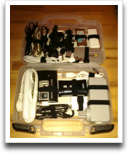Last week, I finally bit the bullet and got new cell phones for my wife and me. (The batteries weren’t holding charges and I’ve been unable to get replacement batteries that hold a charge.) I was very cautious to pick phones that wouldn’t affect my plan, so that pretty much ruled out phones such as the Pre or HTC Hero. As I liked the slider on the Pre I have for work, I decided on the Samsung Reclaim for our new phones (we already had unlimited data for both our phones; unlimited data being EVDO Rev. 0 data).
Some may think that this is a step down for me as I’ve had a smartphone pretty much all the time since I first got a Treo 180 on Cingular. Every smartphone I’ve had has been for work and paid for by a client or by work. In addition, I swore off smartphones as my primary phone since the Treo 300 when its battery drained itself on a number of occasions due to OS crashes.
In any case, I’ve had my Reclaim for about a week and my wife has had hers for a day. The primary use of a phone for me is to make phone calls and the Reclaim does that fairly well. I paired the phone with the Bluetooth car kits in both our cars (both car kits are aftermarket, one is a Parrot CK3100 and the other is a Raytel Tellphone 4200) and it works well. As a phone, so far it lives up to what I need.
Battery life is a major concern for me and even playing around with it throughout the day, the battery hasn’t completely drained, so in that regard, it is looking good.
While the phone isn’t a smartphone, its email and web browsing capabilities are quite respectable. Email can’t show HTML, but I don’t see that being a bad thing. I was able to setup my Gmail account quickly and reading email isn’t half bad. The keyboard is small, but usable. If you don’t have big fingers, you can text and compose email with very few mistakes.
Pros
- Speaker independent voice recognition. (Only some smartphones have this which is surprising as my 3 year old Motorola RAZR had it.)
- Battery life appears to be good.
- Keyboard is usable despite it’s small size.
- Decent email client.
- Good value for the money (phone was free with a 2 year contract renewal; I just had to pay taxes on it).
- Very compact size.
- Easy to navigate using one hand.
Cons
- I’m unable to use Google Maps even though there is an icon for it; I’m getting a SAX error when I download the handler. I’ll need to contact Sprint about this.
- Sending a bunch of contacts over Bluetooth from my Mac resulted in 1 entry, so I had to send them one at a time and I’m not quite done with this.
- Sending contacts from my wife’s RAZR to the Reclaim failed when it got to an entry with a / in it. I’m not sure if this was on the sending or receiving end, but I tend to blame the receiver as it gave the failure message.
- Email can’t display HTML messages.
- Web browser isn’t a full browser.
- Only a limited number of J2ME applications can be loaded onto the phone and most aren’t very exciting.
- The Sprint network can’t do voice and data at the same time; it’s a minor inconvenience.
- Dialing phone numbers that aren’t contacts is a little harder than on the RAZR.
- Contacts and calendar don’t sync with Google where I store all my info.
Summary
While I’ve only had this phone a short time, I don’t plan on returning it. It looks like it is going to more than adequately meet my needs. It is a basic messaging phone that I think can meet the needs of many users. Many of the features of a smartphone will go unused and paying extra for features that you don’t need doesn’t appeal to me.
If you’re on Sprint and looking to replace a phone, the Reclaim is a good phone. The “green” aspect may appeal to some, but to me, it’s just a gimmick. My wife has never had any type of messaging phone and is really enjoying the phone. While she wanted a BlackBerry, I couldn’t justify adding the BlackBerry plan and then text messaging on top of that. For her needs, this phone is comparable to the BlackBerry.
